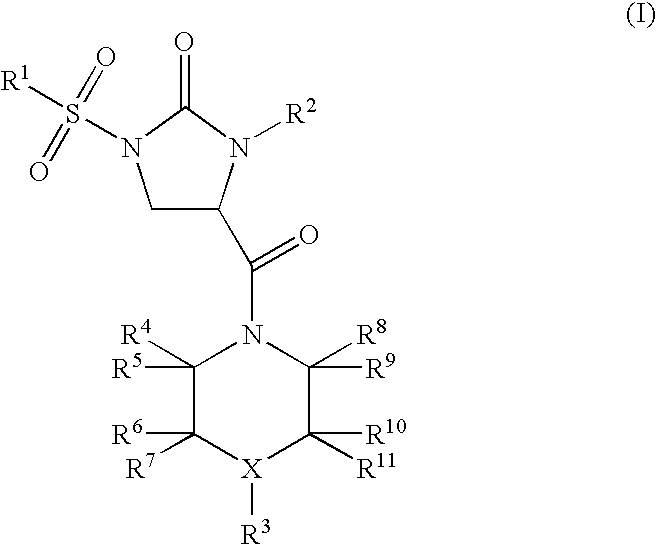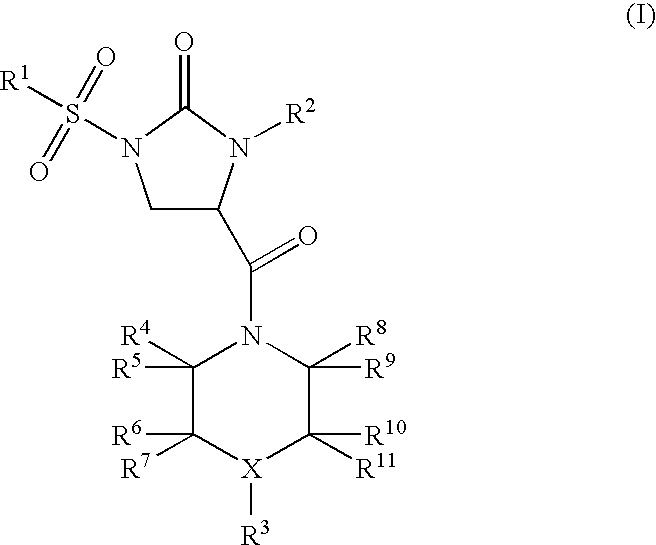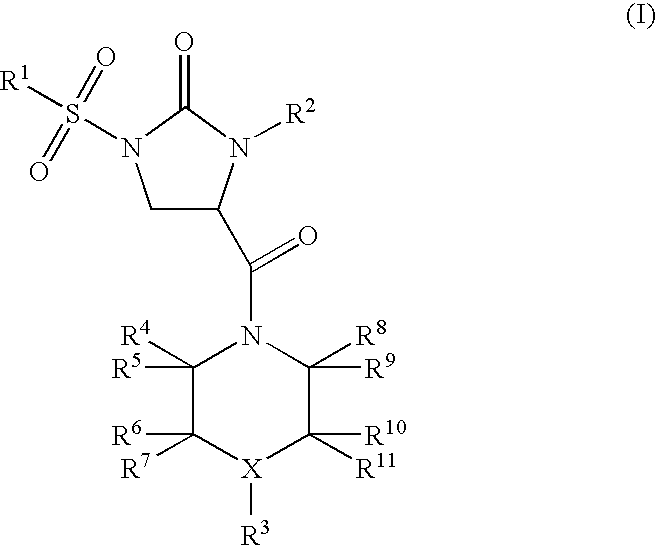Imidazolidinone derivatives
a technology of imidazolidinone and derivatives, which is applied in the direction of drug compositions, antibacterial agents, metabolic disorders, etc., can solve the problems of limiting the therapeutic potential of this approach, unphysiologically high levels of insulin, and ultimately decreasing
- Summary
- Abstract
- Description
- Claims
- Application Information
AI Technical Summary
Problems solved by technology
Method used
Image
Examples
example 1
(RS)-4-[4-(2,5-Dimethyl-phenyl)-piperazine-1-carbonyl]-1-(3-methoxy-benzenesulfonyl)-3-phenyl-imidazolidin-2-one
[0219]Step 1: To a suspension of DL-serinemethylester hydrochloride (0.481 g) in dichloromethane (5 ml) was added 3-methoxybenzene sulfonylchloride (0.639 g). N-Ethyl-diisopropylamine (0.839 g) was added and the mixture was stirred at room temperature for 16 h. The reaction mixture was washed with water. The organic phase was dried (MgSO4), filtered and evaporated to dryness. The crude product was used in the next step without further purification.
[0220]Step 2: The crude product of step 1 was dissolved in tetrahydrofuran (5 ml). The solution was cooled to 0° C. under an argon atmosphere. Triphenylphosphine (0.896 g) and diethylazodicarboxylate (DEAD, 0.595 g) were added. The mixture was stirred for 1 day at room temperature. The solvent was evaporated. The product was purified by chromatography (SiO2, cyclohexane / ethyl acetate 4:1=>1:4) to give (RS)-1-(3-methoxy-benzenesul...
example 2
(RS)-1-Benzenesulfonyl-4-[4-(2,5-dimethyl-phenyl)-piperazine-1-carbonyl]-3-phenyl-imidazolidin-2-one
[0224]Step 1: DL-serine (1.051 g) was dissolved in a 1 M aqueous NaOH solution (20 ml). Benzenesulfonyl chloride (1.77 g) was added at 0° C. After 30 min the ice bath was removed and the mixture was stirred for 18 h at room temperature. The mixture was again placed in an ice bath. The mixture was acidified to pH 1 using 25% aqueous HCl. The colorless precipitate was collected by filtration, washed with 1 M HCl and dried to give (RS)-2-benzenesulfonylamino-3-hydroxy-propionic acid (1.23 g) as a colorless solid.
[0225]Step 2: (RS)-2-benzenesulfonylamino-3-hydroxy-propionic acid (1.204 g) was dissolved in tetrahydrofuran (15 ml) and cooled to 0° C. 1-(2,5-Dimethylphenyl)-piperazine (1.12 g), (benzotriazol-1-yloxy)-tris-(dimethylamino)-phosphonium-hexafluorophosphate (BOP reagent, 3.26 g) and N-ethyl-diisopropylamine (1.90 g) were added. The mixture was stirred at room temperature for 18 h...
example 3
(RS)-1-(3-Methoxy-benzenesulfonyl)-4-[4-(2-methoxy-phenyl)-piperazine-1-carbonyl]-3-phenyl-imidazolidin-2-one
[0228]In analogy to example 1, (RS)-1-(3-methoxy-benzenesulfonyl)-2-oxo-3-phenyl-imidazolidine-4-carboxylic acid (step 4 of example 1) was reacted with 1-(2-methoxyphenyl)-piperazine to give the title compound as a colorless solid. MS: 551.3 ([MtH]+)
PUM
| Property | Measurement | Unit |
|---|---|---|
| temperature | aaaaa | aaaaa |
| temperatures | aaaaa | aaaaa |
| temperatures | aaaaa | aaaaa |
Abstract
Description
Claims
Application Information
 Login to View More
Login to View More - R&D
- Intellectual Property
- Life Sciences
- Materials
- Tech Scout
- Unparalleled Data Quality
- Higher Quality Content
- 60% Fewer Hallucinations
Browse by: Latest US Patents, China's latest patents, Technical Efficacy Thesaurus, Application Domain, Technology Topic, Popular Technical Reports.
© 2025 PatSnap. All rights reserved.Legal|Privacy policy|Modern Slavery Act Transparency Statement|Sitemap|About US| Contact US: help@patsnap.com



